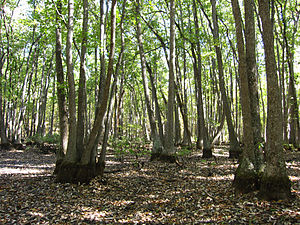Marsh tupelo tree
| Marsh tupelo tree | ||||||||||||
|---|---|---|---|---|---|---|---|---|---|---|---|---|

Marsh tupelo tree ( Nyssa biflora ) |
||||||||||||
| Systematics | ||||||||||||
|
||||||||||||
| Scientific name | ||||||||||||
| Nyssa biflora | ||||||||||||
| Walter |
The marsh tupelo tree ( Nyssa biflora ) is a species of the genus Tupelo trees ( Nyssa ) within the dogwood family (Cornaceae). Common English names are swamp tupelo, swamp black-gum.
description
The marsh tupelo tree has tiny greenish-white flowers . The flowering time is in spring, usually at the end of April.
The drupe is unripe green and ripe, usually in early November, dark blue.
ecology
The marsh tupelo tree develops a taproot and has a swollen base at the height of the mean water table of the growing season. Water roots, which develop under flood conditions, serve to supply and store nutrients. These specialized roots tolerate high levels of carbon dioxide , oxidize the rhizosphere and continue breathing under anaerobic conditions . They are therefore key for the swamp tupelo tree to thrive in flooded habitats.
Insects, primarily bees , are the main pollinators ; however, the pollen is also spread by wind.
The seeds usually overwinter and germinate the following spring. Germination does not occur when the seeds are under water, but begins when the water level drops below the soil surface. It runs rapidly in a moist, ventilated environment at more than 21 ° C. After germination, the seedling has to grow quickly to keep the tip of the shoot and the leaves above water, otherwise it would be killed. In contrast, flooding during the resting phase has no negative effect.
Occurrence
Nyssa biflora occurs in the United States in the coastal plains of Delaware , eastern Maryland and southeastern Virginia south to southern Florida and west to eastern Texas . Its distribution area extends northward up the Mississippi valley to southern Arkansas and westward to southern Tennessee .
The swamp tupelo tree grows in wetlands . The swamp tupelo tree grows in warm and humid climates . Not only does it tolerate flooding, but it currently thrives in such conditions. It is rarely found in locations that are not flooded for most of the growing season. Nyssa biflora grows in fractures , so-called “strands” (flat wet forests without pronounced watercourses), smaller standing waters, river beds, bays and estuaries , provided the water level is not too high.
The water regime is more important for the occurrence of the swamp tupelo tree than the soil type . The best conditions are provided by water-saturated soils, in which the water moves very slowly. Growth can be reduced by up to 50% in standing water such as ponds. Interrupted floods with periodic dry phases or high floods even with running water also reduce growth.
Trees and shrubs that are associated with the marsh tupelo tree are red maple ( Acer rubrum ), western button bush ( Cephalanthus occidentalis ), Cliftonia monophylla , dogwood species ( Cornus spec.), Cyrilla racemiflora , Forestiera acuminata , Fraxinus caroliniana , Gordonia lasianthus , Ilex cassine , Ilex glabra , Ilex vomitoria , Lyonia lucida and Myrica spec.
Individual evidence
- ↑ Nyssa biflora Walter . Retrieved February 20, 2016.
- ↑ a b c d e f g h i Charles E. McGee, Kenneth W. Outcalt: Nyssa sylvatica . USDA , US Forest Service , Southern Research Station. Retrieved July 3, 2019.